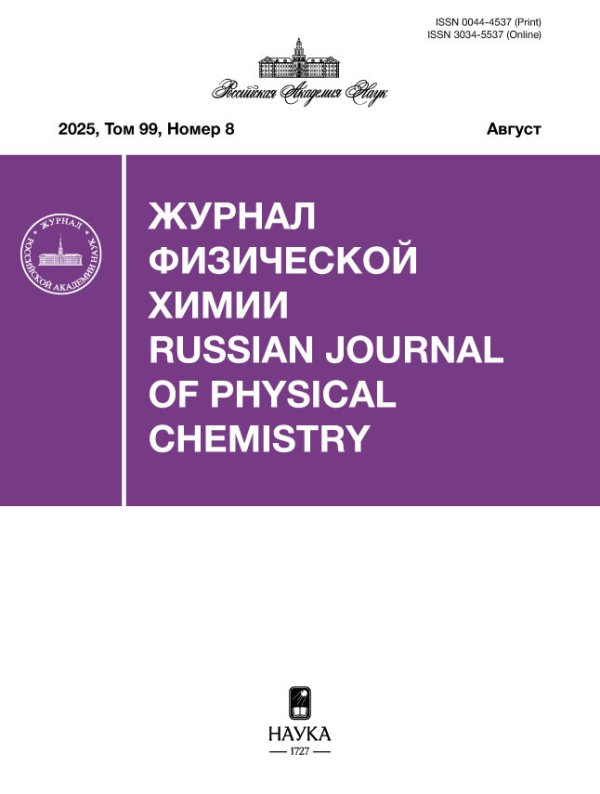Alkaline Carbonization of Polyacrylonitrile for the Preparation of Microporous Carbon Materials
- Authors: Efimov M.N.1, Zhilyaeva N.A.2, Muratov D.G.1, Vasilev A.A.1, Yushkin A.A.1, Karpacheva G.P.1
-
Affiliations:
- Topchiev Institute of Petrochemical Synthesis, Russian Academy of Sciences
- 119991, Moscow, Russia
- Issue: Vol 97, No 1 (2023)
- Pages: 112-120
- Section: PHYSICAL CHEMISTRY OF NANOCLUSTERS, SUPRAMOLECULAR STRUCTURES, AND NANOMATERIALS
- Submitted: 27.02.2025
- Published: 01.01.2023
- URL: https://innoscience.ru/0044-4537/article/view/668885
- DOI: https://doi.org/10.31857/S0044453723010077
- EDN: https://elibrary.ru/BBPDEA
- ID: 668885
Cite item
Abstract
A method has been proposed for the synthesis of activated carbon materials (ACMs) based on polyacrylonitrile (PAN) by activation with potassium hydroxide under the action of IR heating. Two approaches to the chemical activation of the polymer precursor were presented: formation of ACM based on PAN preliminarily heat-treated at 200°C and based on PAN carbonized at 700°C by impregnation with an aqueous alkali solution followed by heating to 800°C. Due to the use of IR radiation, the heating can be performed at a rate of 50 K/min, and the exposure time at a given temperature can be reduced to 2 min. The dependence of the specific surface area and porosity of ACM according to BET on the synthesis conditions was studied. The proposed approaches lead to the formation of ACMs with specific surface areas of 1091 and 2121 m2/g, respectively.
About the authors
M. N. Efimov
Topchiev Institute of Petrochemical Synthesis, Russian Academy of Sciences
Email: efimov@ips.ac.ru
119991, Moscow, Russia
N. A. Zhilyaeva
119991, Moscow, Russia
Email: efimov@ips.ac.ru
119991, Moscow, Russia
D. G. Muratov
Topchiev Institute of Petrochemical Synthesis, Russian Academy of Sciences
Email: efimov@ips.ac.ru
119991, Moscow, Russia
A. A. Vasilev
Topchiev Institute of Petrochemical Synthesis, Russian Academy of Sciences
Email: efimov@ips.ac.ru
119991, Moscow, Russia
A. A. Yushkin
Topchiev Institute of Petrochemical Synthesis, Russian Academy of Sciences
Email: efimov@ips.ac.ru
119991, Moscow, Russia
G. P. Karpacheva
Topchiev Institute of Petrochemical Synthesis, Russian Academy of Sciences
Author for correspondence.
Email: efimov@ips.ac.ru
119991, Moscow, Russia
References
- Mochalin V.N., Shenderova O., Ho D., Gogotsi Y. // Nat. Nanotechnol. 2012. V. 7. P. 11. https://doi.org/10.1038/nnano.2011.209
- Wang J., Kaskel S. // J. Mater. Chem. 2012. V. 22. P. 23710. https://doi.org/10.1039/C2JM34066F
- Speranza G. // Nanomater. 2021. V. 11. P. 967. https://doi.org/10.3390/nano11040967
- Lazarotto J.S., da Boit Martinello K., Georgin J. et al. // Chem. Eng. Res. Des. 2022. V. 180. P. 67. https://doi.org/10.1016/j.cherd.2022.01.044
- Pui W.K., Yusoff R., Aroua M.K. // Rev. Chem. Eng. 2019. V. 35. P. 649. https://doi.org/10.1515/revce-2017-0057
- Abalyaeva V.V., Efimov M.N., Efimov O.N. et al. // Electrochim. Acta. 2020. V. 354. P. 136671. https://doi.org/10.1016/j.electacta.2020.136671
- Zheng L., Li W.B., Chen J.L. // RSC Adv. 2018. V. 8. P. 29767. https://doi.org/10.1039/C8RA04367A
- Efimov M.N., Mironova E.Y., Vasilev A.A. et al. // J. Environ. Chem. Eng. 2021. V. 9. P. 106429. https://doi.org/10.1016/j.jece.2021.106429
- Iwanow M., Gärtner T., Sieber V., König B. // Beilstein J. Org. Chem. 2020. V. 16. P. 1188. https://doi.org/10.3762/bjoc.16.104
- Mopoung S., Dejang N. // Sci. Rep. 2021. V. 11. P. 13948. https://doi.org/10.1038/s41598-021-93249-x
- Januszewicz K., Kazimierski P., Klein M. et al. // Mater. 2020. V. 13. P. 2047. https://doi.org/10.3390/ma13092047
- Franco D.S.P., Georgin J., Netto M.S. et al. // Environ. Sci. Pollut. Res. 2022. V. 29. P. 31085.https://doi.org/10.1007/s11356-021-17846-z
- Cao Y., Wang K., Wang X. et al. // Electrochim. Acta. 2016. V. 212. P. 839. https://doi.org/10.1016/j.electacta.2016.07.069
- Suhas Gupta V.K., Carrott P.J.M. et al. // Bioresour. Technol. 216 (2016) 1066–1076. https://doi.org/10.1016/j.biortech.2016.05.106
- Wu Q., Liang D., Ma X. et al. // RSC Adv. 2019. V. 9. P. 26676. https://doi.org/10.1039/C9RA04959B
- Munoz M., Kolb V., Lamolda A. et al. // Appl. Catal. B Environ. 2017. V. 218. P. 498. https://doi.org/10.1016/j.apcatb.2017.07.001
- Ma J., Liu J., Song J., Tang T. // RSC Adv. 2018. V. 8. P. 2469. https://doi.org/10.1039/C7RA12733B
- Sevilla M., Valle-Vigón P., Fuertes A.B. // Adv. Funct. Mater. 2011. V. 21. P. 2781. https://doi.org/10.1002/adfm.201100291
- Díez N., Sevilla M., Fombona-Pascual A., Fuertes A.B. // Batter. Supercaps. 2022. V. 5. P. e202100169. https://doi.org/10.1002/batt.202100169
- Li K., Wang C. et al. // Res. Chem. Intermed. 2020. V. 46. P. 3459. https://doi.org/10.1007/s11164-020-04156-1
- de Paula F.G.F., de Castro M.C.M., Ortega P.F.R. et al. // Microporous Mesoporous Mater. 2018. V. 267. P. 181. https://doi.org/10.1016/J.MICROMESO.2018.03.027
- Shen W., Zhang S., He Y. et al. // J. Mater. Chem. 2011. V. 21. P. 14036. https://doi.org/10.1039/C1JM12585K
- Ma C., Bai J., Hu X. et al. // J. Environ. Sci. 2023. V. 125. P. 533. https://doi.org/10.1016/J.JES.2022.03.016
- Podyacheva O.Y., Cherepanova S.V., Romanenko A.I. et al. // Carbon N. Y. 2017. V. 122. P. 475. https://doi.org/10.1016/j.carbon.2017.06.094
- Podyacheva O.Y., Ismagilov Z.R. // Catal. Today. 2015. V. 249. P. 12. https://doi.org/10.1016/j.cattod.2014.10.033
- Zhao L., Wang Y., Li W. // RSC Adv. 2016. V. 6. P. 90076. https://doi.org/10.1039/C6RA17049H
- Wang Y., Fugetsu B., Wang Z. et al. // Sci. Rep. 2017. V. 7. P. 40259. https://doi.org/10.1038/srep40259
- Gao L., Lu H., Lin H. et al. // Chem. Res. Chinese Univ. 2014. V. 30. P. 441. https://doi.org/10.1007/s40242-014-4059-1
- Hsiao H.Y., Huang C.M., Hsu M.Y., Chen H. // Sep. Purif. Technol. 2011. V. 82. P. 19. https://doi.org/10.1016/j.seppur.2011.08.006
- Marrakchi F., Ahmed M.J., Khanday W.A. et al. // Int. J. Biol. Macromol. 2017. V. 98. P. 233. https://doi.org/10.1016/J.IJBIOMAC.2017.01.119
- Novais R.M., Caetano A.P.F., Seabra M.P. et al. // J. Clean. Prod. 2018. V. 197. P. 1137. https://doi.org/10.1016/J.JCLEPRO.2018.06.278
- Efimov M.N., Vasilev A.A., Muratov D.G. et al. // J. Environ. Chem. Eng. 2019. V. 7. P. 103514. https://doi.org/10.1016/J.JECE.2019.103514
- Yushkin A.A., Efimov M.N., Malakhov A.O. et al. // React. Funct. Polym. 2021. V. 158. P. 104793. https://doi.org/10.1016/j.reactfunctpolym.2020.104793
- Юшкин А.А., Ефимов М.Н., Васильев А.А. и др. // Мембраны и мембранные технологии. 2017. Т. 7. С. 125. https://doi.org/10.1134/S2218117217020080
- Lee W.H., Bae J.Y., Yushkin A. et al. // J. Memb. Sci. 2020. V. 613. P. 118477. https://doi.org/10.1016/j.memsci.2020.118477
- Sakamoto T., Amano Y., Machida M. // SN Appl. Sci. 2020. V. 2. No 4. P. 702. https://doi.org/10.1007/s42452-020-2465-1
- Ruhland K., Frenzel R., Horny R. et al. // Polym. Degrad. Stab. 2017. V. 146. P. 298. https://doi.org/10.1016/j.polymdegradstab.2017.10.018
- Rahaman M.S.A., Ismail A.F., Mustafa A. // Polym. Degrad. Stab. 2007. V. 92. P. 1421. https://doi.org/10.1016/j.polymdegradstab.2007.03.023
- Ferrari A.C., Robertson J. // Philos. Trans. R. Soc. London. Ser. A Math. Phys. Eng. Sci. 2004. V. 362. P. 2477. https://doi.org/10.1098/rsta.2004.1452
- Vasiliev V.P., Manzhos R.A., Kochergin V.K. et al. // Mater. 2022. V. 15. P. 821. https://doi.org/10.3390/ma15030821
Supplementary files


















